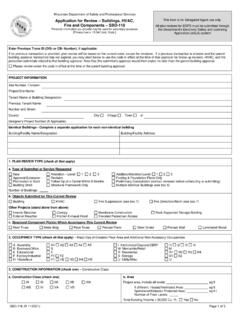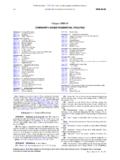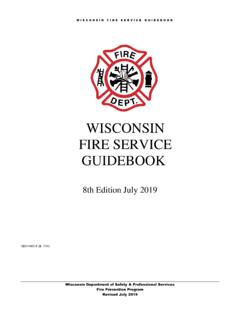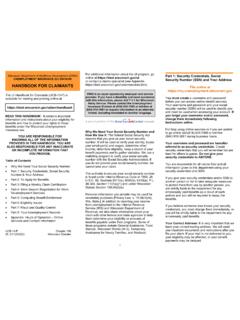Transcription of A GUIDE TO PLANNING AND INSTALLING DRY FIRE HYDRANTS
1 A GUIDE . TO PLANNING AND INSTALLING . DRY fire . HYDRANTS . BY. John Pohlman Robert White Forester-Ranger Forestry Technician Advanced wisconsin Dept. of Natural Resources N4103 WSH27. Ladysmith, WI 54848-9309 USA. Publ. FR-044 97 REV. TABLE OF CONTENTS. PREFACE .. 1. PLANNING YOUR HYDRANT 1. FIELD CHECKING LOCATIONS & DESIGN CONSIDERATIONS .. 1. COSTS .. 3. PERMITS AND LAND USE AGREEMENTS .. 4. INSTALLATION OF HYDRANTS .. 4. FOLLOW-UP .. 10. CHART A .. 10. CHART B .. 11. CHART C .. 12. DRY HYDRANT SYSTEM COMPONENTS .. 13. DESIGN WORKSHEET .. 14. EXAMPLE 1 .. 15. APPENDIX A Form 3500-96 .. 16. APPENDIX B Sample Drawing & Blank 18. APPENDIX C - Map .. 20. APPENDIX D Land Use Agreement .. 21. APPENDIX E - Resolution .. 23. FIGURE 1 .. 24. FIGURE 2 .. 25. FIGURE 3 .. 26. SEASONAL HYDRANT 27. FIELD NOTES .. 28.
2 PUB- FR-044 97 REV. The wisconsin Department of Natural Resources provides equal opportunity in its employment, programs, services and functions under an Affirmative Action Plan. If you have any questions, please write to Equal Opportunity Office, Department of Interior, Washington, 20240. This publication is available in alternative format (large print, Braille, audio tape, etc.) upon request. Please contact the wisconsin Department of Natural Resources, Bureau of Forestry--FR/4, Box 7921, Madison, WI 53707, phone: 608-267-7494. i ii PREFACE. This booklet is intended to assist fire service personnel, municipal agencies, and private companies or individuals in the PLANNING and installation of 'Dry fire HYDRANTS '. Since each installation will be unique in itself, we will try to present an orderly method to plan for and install a Dry fire Hydrant system.
3 Personnel involved in INSTALLING a dry fire hydrant system are encouraged to read this booklet thoroughly before beginning fieldwork on the project. Installation tips were obtained from numerous fire departments throughout wisconsin , along with the experiences of several fire departments from Rusk County, wisconsin . The installation procedures described in this booklet apply to the use of 6" Schedule 40 PVC pipe for the hydrant. Some alterations in the installation methods will be necessary for other types of materials that may be used for hydrant installation. The dry fire hydrant system described is designed to be used with fire department engines and/or high volume pumps, not small portable pumps. Products mentioned in this booklet are examples of materials that are available for use in a dry fire hydrant project.
4 The wisconsin Department of Natural Resources does not endorse any specific product or manufacturer. Other recommended materials to help in the PLANNING and installation processes are: 1.) A video production that goes with this booklet entitled PLANNING for and INSTALLING Dry fire HYDRANTS is available from the wisconsin Department of Natural Resources, Tomahawk, WI 54487. Cost is $ , ppd. 2.) A booklet and video entitled Operation Water produced by the NFPA and available from the National Interagency fire Center, Boise, ID 83705. Cost is $ , ppd. 3.) NFPA 1231, Standard for Water Supplies for Suburban and Rural fire Fighting, 1993 edition, available from NFPA, Box 9101, Quincy, MA 02269. We hope that the enclosed information will assist you in the PLANNING and installation of your dry fire hydrant system.
5 Comments and pictures of your installation would be appreciated. If you should have questions that are not covered in this booklet or tips and ideas on dry fire HYDRANTS that you would like to share with other fire service personnel, you may contact the authors at: wisconsin Department of Natural Resources, N4103 WSH 27, Ladysmith, WI 54848-9309 USA Telephone (715) 532-3911 John Pohlman, Forester- Ranger or Robert White, Forestry Technician Advanced, Revised January 1997. PLANNING YOUR HYDRANT LOCATIONS. A. If this is a countywide or multiple jurisdiction project, set up a meeting between all of the area fire departments and/or municipal agencies involved. If you are located within a DNR organized fire control area, consider inviting the DNR fire Officer. These people should know the waters of their particular fire jurisdictions very well.
6 The local DNR. fire Officer can assist with maps, permits, fill-site information, and RCFP Title IV Grant applications. In this way you can plan the location of the dry fire HYDRANTS to avoid two departments placing HYDRANTS right next to each other. In some cases, one fire department might have to cross over into another fire jurisdiction for a good water source, thus creating the situation that two fire departments are sharing a single dry fire hydrant. When this occurs, it generally balances out between the involved departments and helps to reduce the cost to all departments involved in the project. B. On a county or jurisdictional map, locate the areas in which you would like to install a dry fire hydrant. You may wish to consider population trends, property valuation, loss potential, and fire history to help prioritize your selections.
7 Mark each location, along with its priority, on the map. Consider INSTALLING high priority HYDRANTS first, and others in future years as a long-range plan. Once you have found the general areas, locate the closest water sources; ( , lakes, streams, flowages, farm ponds, etc.) that may serve as a hydrant location. Three miles or less between HYDRANTS is a good average distance to keep turn around time to a reasonable minimum. 1. FIELD CHECKING LOCATIONS & DESIGN CONSIDERATIONS. After the locations have been mapped, it is time to check them out in the field. Some of the things to look for during field checking are: A. Determine the riparian land owner at the site location. You need their permission to do the work on their property. BE SURE TO GET THE PERMISSION IN WRITING !! Also, if the hydrant is on a road ROW, you will need town, county or state DOT approval(s).
8 If a railroad owns the property, you will need their permission and may be required to pay a land use fee. If the town or county owns the property you will be digging on, you will need their permission. Obtaining written permission may take some time and, in the case of town or county ownership, may require the town board or county board to pass a resolution permitting your activity. (See Permits and Land Use Agreements on page 5). B. Depth of water at the site during the lowest water levels of the year. This is the most critical consideration. You need a minimum of 4' to 5' of water over the suction screen and pipe during low water. This will prevent freeze-out of the screen, obstructions to navigation, and reduce the chance of water swirl (cavitation) while drafting. The depth of water can be checked by boat with a depth line or stick.
9 You may also use Scuba divers if they are available from local clubs. Take into consideration the 25, 50, and 100 year water levels if this information is available. This will give you an idea of what kind of low and high water levels you can expect during drought or flood years. C. What is the composition of the bottom of the lake, stream or pond? You need a sand, sand/gravel, gravel, or gravel/rock type of bottom for the hydrant to work well. Otherwise, muck and/or vegetative matter may clog up the suction screen. You may be able to purchase some type of mat to lay down under your suction screen to retard vegetative matter from growing up into your screen, or if you have enough water depth, you can raise the screen up off the bottom. D. Check the ease of digging. Can a large backhoe get close enough to the water or out into the water to reach out and get down at least 5 feet below the surface of the water to start the trench?
10 E. Consider how you are going to protect the hydrant connection from damage or burial by snow. Do you need to put in posts, etc. to serve as a crash barrier? How will you mark the hydrant to avoid it being hit by a snow plow? Who will be responsible for keeping the hydrant locations open in the winter? What type of suction hose support do you need? F. After you have found the required water depth and if the area is suitable for a hydrant location, measure to the shore to figure out the amount of pipe that will be needed in the water. Commercially made screens are generally 5 feet in length and should be included in this measurement. Then measure from the shoreline to the location for the hydrant connection. Add the vertical riser height to these figures to give you the approximate total feet of pipe for the installation.







